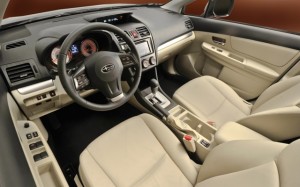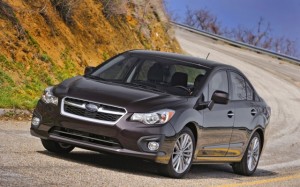Sometimes it seems like Subaru is the Rodney Dangerfield of auto manufacturers… they just don’t get any respect. They make excellent cars but when it is time to buy a new one most people forget that Subaru even exists. The truth is, if you want a well made, all-wheel drive vehicle at a reasonable price, Subaru is awfully hard to beat. Before I go any farther, journalistic integrity requires that I point out that my wife and I have owned 5 Subarus in the last 15 years (1 Impreza, 3 Foresters and a Baja) so it’s possible I am just a little biased. Forgive me, I simply like Subarus.
Still, as much as I like Subarus it is a fact that they haven’t always been particularly stylish (most would say the Baja was downright ugly — it tends to make everyones top ten ugly auto list), but trust me, their styling has improved a lot over the past 5 or 6 years. Which is not too surprising when you consider that it was 8 years ago when Toyota bought a small share of Subaru’s parent company, Fuji Heavy Industries, from General Motors. While its true that Toyotas also aren’t always the best looking cars they are seldom ugly in a way that older Subarus truly mastered (if you doubt me, look at some of the early versions of the Subaru Tribeca).
The first Subaru to benefit from Toyota’s styling influence was the Forester. The Forester, always a solid, dependable block of a car is now an attractive one. Next up was the Outback and now it is the Impreza’s turn. The Impreza, like the Forester, badly needed a face lift and got it. While not a work of art — I’ll leave that to BMW and Audi — the Impreza is a decent looking car and a lot cheaper than the two afore mentioned luxury cars.
The Impreza is the least expensive Subaru made, starting at $17,895. Like all Subarus, except the new rear-wheel drive BRZ, the Impreza features all-wheel drive as standard. Also, like all Subarus, including the BRZ, the Impreza has a boxer engine. What makes boxer engines unique is the pistons are parallel to the ground rather than upright or in a V shape like most car engines. Having the pistons lay flat has several important benefits: because the engine isn’t as tall as most, Subarus tend to have a lower center of gravity. The lower center of gravity means Subarus handle better and are more stable than most of their competition. Also, the hood of the car can slope down more, making it easer to see over while also making the car more aerodynamic. Finally, the punch-counterpunch motion of the pistons helps cancel out engine vibration.
In the past one of the knocks against Subarus has been their less than stellar fuel efficiency. Given that Imprezas have traditionally been a small car, you might have expected it to do better than 19 mpg in the city and 24 mpg on the highway (the EPA numbers for the 2003 Impreza). The similarly sized 2003 Toyota Corolla got 25 city, 34 highway. These days the Impreza’s mileage is substantially better due to a redesigned engine and Subaru’s adoption of Continuously Variable Transmissions (CVTs) for most of their auto lineup. For 2013 the EPA rates the Impreza at 27 city, 36 highway (for comparison the 2013 Toyota Corolla is rated at 26 city, 34 highway). Continuously variable transmissions allow engines to perform at maximum efficiency — the so called “sweet-spot” — where an engine best combines fuel efficiency with performance. Early CVT’s tended to be noisy and sometimes unreliable but those issues have all but disappeared. Today’s CVTs are quiet, reliable and, best of all, very fuel efficient. As an added bonus, they are fun to drive because they aren’t constantly shifting gears (they don’t have any) and they generally have more torque and more torque translates to more power when you need it.
There are several models of Impreza to choose from ranging from frugal and practical to expensive and sporty. One of the nice things about the Impreza is even the inexpensive ones are fairly well equipped, have excellent visibility and are remarkably fun to drive… especially equipped with a stick shift. The boxer engine provides plenty of power and the low center of gravity eliminates a lot of the body roll you’ll find in other cars in the same price range. When the low center of gravity is combined with a turbo-charged engine, quick steering and a sport suspension — as it is in the WRX version — you have a car with sport seats that handles and accelerates as well as some BMWs but at a much lower price. Several years ago Car and Driver compared the WRX with a BMW 330xi and an Audi S4 Quattro. Since the Audi was more than 16-thousand dollars more than the WRX it shouldn’t be surprising that it came in first, but the BMW finished last. Subaru lost to the Audi by one point.
 So, what is the Impreza like to drive? Pretty good. As mentioned early, virtually all Subarus handle well and have decent acceleration. They’ve become much quieter over the years and, possibly due to Toyota’s influence, offer a more attractive interior. The Impreza interior won’t be confused with a BMW, but it is well laid out and functional. Plus the Impreza has what is possibly the best all-wheel drive system offered by any manufacturer. If you haven’t driven a Subaru with all-wheel drive, do so, especially in the rain or snow. It really makes a difference.
So, what is the Impreza like to drive? Pretty good. As mentioned early, virtually all Subarus handle well and have decent acceleration. They’ve become much quieter over the years and, possibly due to Toyota’s influence, offer a more attractive interior. The Impreza interior won’t be confused with a BMW, but it is well laid out and functional. Plus the Impreza has what is possibly the best all-wheel drive system offered by any manufacturer. If you haven’t driven a Subaru with all-wheel drive, do so, especially in the rain or snow. It really makes a difference.
Even in the base Impreza the seats are comfortable and the electric steering is well-weighted – easy to turn at lower speeds and tightening up at higher speeds. The result is you always feel in control when driving an Impreza.
The bad news is Subaru still doesn’t offer a hybrid. If you aren’t in a winter climate, you could be forgiven for deciding that high gas mileage is more important than all-wheel drive. Personally, I like Subarus even when it isn’t snowy outside because they are so good in the rain, but if you have a long commute that a car that gets better mile per gallon may be worth considering. I’ve included a Competitive Comparison table at the end of this article to help you compare two high mileage contenders: the Toyota Prius II and the Honda Insight LX.
For those of us that don’t need the fuel efficiency of a hybrid and live in climates where driving in snow is a harsh reality of life, the Subaru Impreza is well worth considering. It is one of the least expensive all-wheel drive cars made and is a solid, reliable car. It may not be a BMW, but the sportier models handle almost as well and cost a lot less. Give Subaru some respect and check out the 2013 Impreza.
If you have any questions about the Impreza, feel free to leave a reply. I try to answer questions within 36-hours, often sooner.
Competitive Comparisons
| Subaru Impreza Hatchback Premium | Toyota Prius II | Honda Insight LX | |
| MSRP | $20,165 | $24,200 | $20,375 |
| Miles Per Gallon (City/Hwy.) | 27/36 | 51/48 | 41/44 |
| All-Wheel Drive | Standard | N.A | N.A. |
| Fuel type | Regular | Regular | Regular |
| Transmission | Continuously variable | Continuously variable | Continuously variable |
| Horsepower | 148@6200 | 134@5200 | 98@5800 |
| Torque (lb.-ft.) | 145@4200 | 105@4000 | 123@1000-1700 |
| Overall length (in.) | 173.8 | 176.4 | 172.3 |
| Wheelbase (in.) | 104.1 | 106.3 | 100.4 |
| Overall height (in.) | 57.7 | 58.7 | 56.2 |
| Overall width (in.) | 68.5 | 68.7 | 66.7 |
| Cargo capacity (cu. ft.) rear seat up | 22.5 | 28.9 | 15.9 |
| Bluetooth | Standard | Standard | N.A. |
| Tilt/Telescoping steering wheel | Standard | Standard | Standard |
| Driver seat adjustments | 6-way manual | 6-way manual | 6-way manual |
| Automatic climate control | N.A. | Standard | Standard |
| Smart key | N.A. | Standard | N.A. |
| Radio | AM/FM/CD USB/iPod – 6-speakers | AM/FM/CD USB/iPod – 6-speakers | AM/FM/CD USB/iPod – 4-speakers |
| Daytime running lights | Standard | Standard | Standard |
| Warranty | 36 month/36,000 miles | 36 month/36,000 miles | 36 month/36,000 miles |





